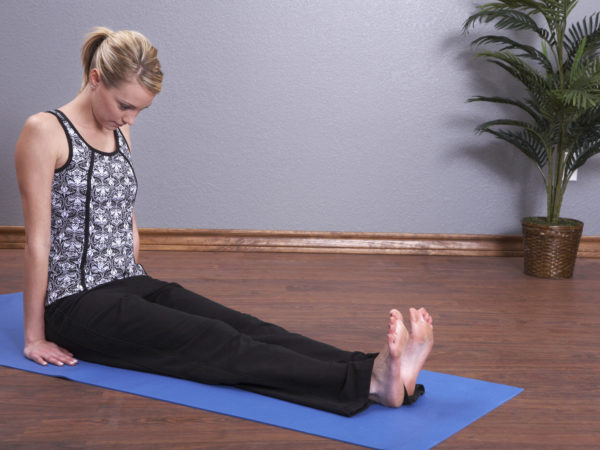Staff Pose

“The Staff Pose is important since other poses build upon this base. It is a great beginner’s pose that provides many benefits.” – Andrew Weil, M.D.
Description & History
The Staff Pose is the foundation of all other seated, forward bend, and twist postures in yoga. The Sanskrit name, Dandasana, comes from danda meaning stick or staff and asana meaning posture. It is believed to support digestion and relieve sciatica. While not a difficult pose to perform, it is important to focus on proper form to avoid back injury.
How to Perform Staff Pose
- Begin by sitting on the floor with your legs together and extended in front of your body. Make sure your torso is perpendicular to the floor. Place your hands on the floor with palms down directly adjacent to your hips.
- Flex your ankles and lift your toes toward your body so your hamstring muscles and calves are taut. Firm up your thighs rotating them slightly in while drawing your groin muscles toward your sacrum.
- Imagine your spine is a staff running through the core of your torso – it supports, lengthens and gives shape to your body. Hold the Staff Pose for one minute or longer.
Potential Health Benefits
- Improves posture
- Stretches the muscles of the back, legs, and hips
- Relieves sciatica
- Opens the chest and lungs to aid breathing
- Stimulates abdominal organs
Sitting for extended periods of time can lead to poor posture and eventually musculoskeletal pains. Researchers looked into the effects of practicing yoga poses, one of which was Staff Pose, on musculoskeletal pains, mainly of the upper limbs. Researchers concluded that a yoga regimen was more effective at providing symptom relief than counseling alone. The results were published in the Indian Journal of Medical Sciences.
Modifications & Variations
The Staff Pose is a simple pose requiring a straight back that is perpendicular to the floor. If you are unable to sit fully erect, sit with your back against a wall for support until you are able to do so on your own. When against the wall, your shoulder blades and sacrum should touch the wall, not your head or lower back. You cal always place a towel or blanket between the wall and your lower back. If you do not want to use a wall for support, you can roll up a towel or yoga mat and place it under your “sit bones.”
Precautions
Be careful when practicing the Staff Pose if you have issues with your hands and wrists or if you have chronic back problems like slipped discs or sciatica. Begin slowly and gradually increase the amount of time you perform this pose.
Related Poses
- Standing Forward Bend (Uttanasana)
- Downward-Facing Dog (Adho Mukha Svanasana)
- Seated Forward Bend (Paschimottanasana)
- Full Boat Pose (Paripurna Navasana)
Reviewed by: James Nicolai, M.D., on August 20th, 2013
Sources
Joshi, V. S., and A. S. Bellad. “Effect of yogic exercises on symptoms of musculoskeletal disorders of upper limbs among computer users: A randomised controlled trial.” Indian journal of medical sciences 65, no. 10 (2011): 424.









